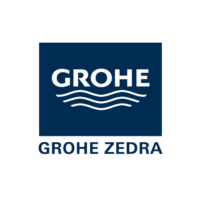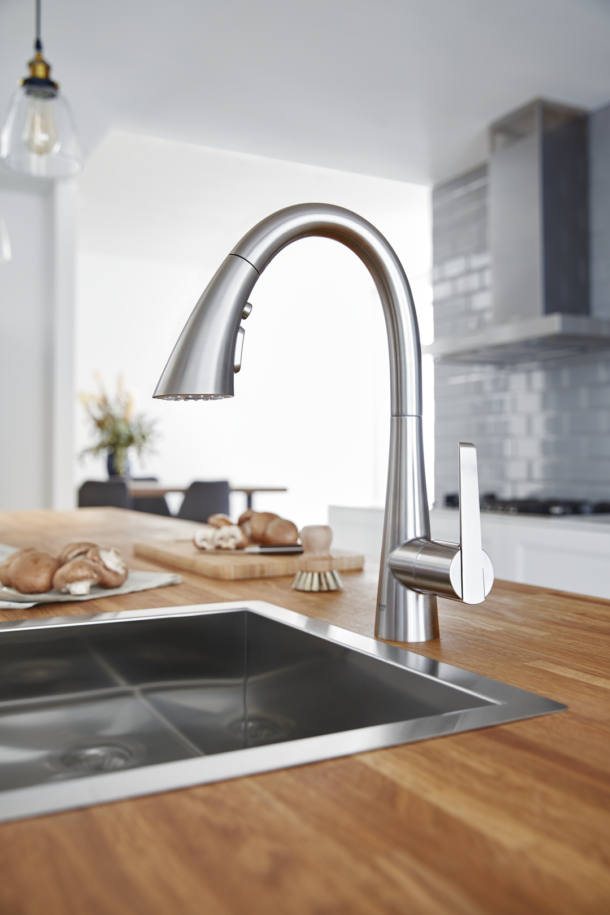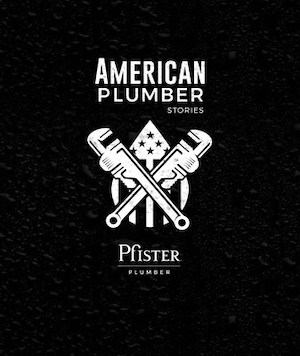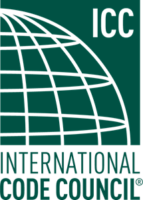Decision Made to Sustain Global Brand Uniformity and Reinforce the Brand’s Commitment to Gender Equality and Inclusiveness GROHE, a leading global brand for bathroom and kitchen water solutions sold in 150 countries worldwide, has announced that its Ladylux kitchen faucet collection is rebranding as GROHE Zedra. The line has long been popularly known as Zedra Read more
Industry News

Decision Made to Sustain Global Brand Uniformity and Reinforce the Brand’s Commitment to Gender Equality and Inclusiveness
GROHE, a leading global brand for bathroom and kitchen water solutions sold in 150 countries worldwide, has announced that its Ladylux kitchen faucet collection is rebranding as GROHE Zedra. The line has long been popularly known as Zedra in much of the world outside of the U.S. and Canada, and the decision for this shift is to ensure global brand consistency in the future, as well as to better align with GROHE’s corporate values and commitment to gender equality and inclusiveness.
“GROHE is pleased to announce that our Ladylux kitchen faucet collection will rebrand as GROHE Zedra,” said Theresa Choh-Lee, Leader, GROHE Brand. “This iconic line has long been referred to as Zedra around the world, so this move provides better global consistency. The change also strengthens our commitment to gender equality and inclusiveness while aligning with our corporate values.”

The Ladylux collection was launched in the U.S. and Canada nearly four decades ago and was the first kitchen faucet to introduce an integrated pull-out spray head. The line is synonymous with innovation, design excellence and dedication to making life easy, efficient and aesthetically pleasing, and continues to be admired by consumers, retailers and professionals today. The same Ladylux attributes and state-of-the art technology will continue under the new GROHE Zedra name. Last March, Zedra was honored with the Golden Award – “Best of the Best” in the kitchen faucet and sinks category of the 2021 Kitchen Innovation Award.
“GROHE Zedra offers the same innovation and precision German design and engineering that you have come to enjoy in your Ladylux kitchen faucet, simply under the new, globally recognized GROHE Zedra name,” added Choh-Lee.
Washington — The IAPMO Group and Plumbing Manufacturers International (PMI) applaud the House Science, Space and Technology Committee for advancing legislation this past week reauthorizing the National Institute of Standards and Technology and calling for the creation of a program for premise plumbing research. During the July 27 committee mark-up of the bill, U.S. Rep Read more
Washington — The IAPMO Group and Plumbing Manufacturers International (PMI) applaud the House Science, Space and Technology Committee for advancing legislation this past week reauthorizing the National Institute of Standards and Technology and calling for the creation of a program for premise plumbing research.
During the July 27 committee mark-up of the bill, U.S. Rep. Paul Tonko (D-N.Y.) was successful in offering an important amendment to H.R. 4609, the National Institute of Standards and Technology for the Future Act of 2021, that would authorize funding at NIST to conduct practical, water-related research on systems within homes and buildings, addressing critical issues such as water quality, efficiency, reuse, sustainability and resilience.
A new program at NIST will help to combat a 900% increase in Legionnaires’ disease since 2000. Legionnaires’ disease is an infection caused by the bacteria Legionella. Symptoms of the disease include fever, cough and pneumonia, while a milder infection can look like a flu-like illness without pneumonia. The sickness can be deadly in older patients or those with other risk factors. Reports of the infection are more common in the summer and early fall when warming, stagnant waters present the best environment for bacterial growth in water systems. News articles from across the country detail the prevalence of this public health challenge.
From the exponential growth of Legionnaires’ disease outbreaks to increasing housing affordability, the industry is waiting and ready to apply the findings of this research to tackle major issues,” said IAPMO CEO Dave Viola. “We applaud Rep. Tonko and other committee members for recognizing this need and including it in this important piece of legislation. This will have a direct, positive impact on America’s homes and buildings today and for the foreseeable future.”
Over the years, IAPMO and PMI have worked with Congress and NIST to address and prioritize research needs on plumbing. Rep. Tonko’s amendment is based on legislation developed by Rep. Matt Cartwright (D-PA) and Sen. Tammy Duckworth (D-IL), who have both previously introduced legislation to expand NIST’s efforts on drinking water. In May 2020, NIST published a report that identified nearly 60 specific research needs and challenges faced by the plumbing industry. This report provides a useful roadmap for addressing those needs through applied research and codes and standards activities.
Kerry Stackpole, PMI CEO, said that “American consumers have the benefit of state-of-the-art water efficient plumbing fittings and fixtures; however, the legacy plumbing that carries water to these fixtures in our homes and offices are based on research and data from the 1930s.” Stackpole noted that “updated research and data by NIST, in conjunction with academia, industry and other key stakeholders, would significantly improve the water efficiency and safety in water systems across the nation.”
Another important issue that will be addressed by NIST research is the sizing of plumbing systems in buildings. Much has changed in the way Americans use water since the 1920s and ’30s when Dr. Roy Hunter, working for the National Bureau of Standards, the predecessor to NIST, developed the method for predicting water use demands in a building and determining how large systems need to be to accommodate those demands. While minor updates have been made over the years to these methods, they are still used today in plumbing codes despite the many improvements and efficiencies made to plumbing fixtures, appliances and other water-using equipment in subsequent years. As a result, it is widely recognized that today’s plumbing systems are often grossly oversized, resulting in increased building costs, wasted water and energy, and declining water quality. The research will seek to resolve this problem and lead to a method for determining plumbing system sizes that are more appropriate for the particular building.
Pandemic renovation activity up significantly in the South, West, and Midwest; slows in the Northeast. Branchville, N.J. — Home renovations have increased since the start of 2021, with over half (55%) of U.S. homeowners reporting substantial improvements that boost home values, according to a July survey commissioned by Selective Insurance and conducted by The Harris Read more
Pandemic renovation activity up significantly in the South, West, and Midwest; slows in the Northeast.
Branchville, N.J. — Home renovations have increased since the start of 2021, with over half (55%) of U.S. homeowners reporting substantial improvements that boost home values, according to a July survey commissioned by Selective Insurance and conducted by The Harris Poll. This is a 25% increase from a similar Selective and Harris Poll survey conducted in December 2020, indicating a current rise in home improvements despite headlines about supply chain delays, increasing cost of materials, and labor shortages.
The Selective study also found that the South leads the nation in home renovation activity, with 57% of homeowners reporting significant home improvements. The prevalence of home renovations by region follows: Northeast (54%, down from 56% in December 2020), South (57%, up from 40% in December 2020), Midwest (52%, up from 42% in December 2020), and the West (55%, up from 43% in December 2020).
“Selective’s study on home renovations reinforces our observations, based on customer interactions, that the current housing and renovation boom remains strong,” said Allen Anderson, Senior Vice President, Personal Lines, Selective. “Every home renovation project is unique, but every homeowner needs to protect their investment from future loss. Independent insurance agents help homeowners evaluate their coverage needs and update their insurance to reflect their renovated home’s full replacement value.”
Among homeowners who improved their homes during the pandemic, just under a quarter (23%) said they hadn’t updated their insurance coverage and another 10% said they were unsure.
Additional Insights and Findings
According to the Selective study, U.S. homeowners have been increasingly investing in their properties since the beginning of the pandemic, with the following major home improvement projects reported:
- 36% are renovating a room/basement/attic
- 12% are adding a new room
- 17% are adding a pool/hot tub
Selective saw similar trends among customers who operate contracting businesses. An analysis of Selective’s active commercial liability insurance policies identified a 5-10% increase in residential construction payroll and an approximately 15% increase in subcontracting costs year over year from 2019 through 2021. These indicators underscore continued home improvement activity well into 2021 and across the company’s commercial lines footprint.
Lake Forest, Calif. — Pfister, a trusted leader in the plumbing industry since 1910, is introducing American Plumber Stories, a docuseries that features the lives of plumbers throughout the U.S. The bi-weekly digital series, hosted by country music entertainer and Army veteran Craig Morgan, launches today at www.AmericanPlumberStories.com. American Plumber Stories aims to promote the Read more
Lake Forest, Calif. — Pfister, a trusted leader in the plumbing industry since 1910, is introducing American Plumber Stories, a docuseries that features the lives of plumbers throughout the U.S. The bi-weekly digital series, hosted by country music entertainer and Army veteran Craig Morgan, launches today at www.AmericanPlumberStories.com.

Craig Morgan – Country Music Entertainer and Host of American Plumber Stories
American Plumber Stories aims to promote the plumbing trade to the next generation of professionals. The show highlights the stories of plumbers around the nation including how they got started in the plumbing trade and the passion they have for their profession. These stories show how they built a career that allows them to lead financially rewarding and fulfilling lives.
Featured will be plumbers and their unique hobbies such as car racing, kitesurfing and many other exciting stories. Each episode is entertaining but also highlights the true opportunity the plumbing trade has to offer those who are not aiming to pursue a college education or who are unsure which career path to take. Becoming an “American Plumber” is a true alternative. By foregoing significant student loan debt and entering a career early, young plumbing professionals can build a fulfilling life for themselves and their families.
The plumbing trade has been experiencing a significant shortage of workers. The most experienced professionals are nearing retirement age and are exiting the workforce. At the same time the number of men and women willing to learn the trade continues to decline. Today, special high school programs and vocational or trade schools are scarce for aspiring students who want a career in the trades. Compared to higher learning and the promise and perceived security of a corporate career, there is also a negative stigma attached to the plumbing profession. Academic achievement became more favorable and the idea of trade education was left behind.

“Young men and women who enter the workforce early can learn the plumbing trade and make it a long-term career. This also allows many to establish and build their own company. The goal of American Plumber Stories is to update the perceptions of the plumber profession in a documentary-style format. We need to engage with young people, sharing an authentic look at the plumbing trade today and real plumbers’ success stories to encourage a new workforce,” says Spencer Brown, Pfister’s Director of Sales and executive producer of American Plumber Stories.
“The goals of American Plumber Stories are to inspire, educate and entertain. Our hope is that the docuseries changes the image of the industry, helping to attract and recruit new talent.”

Initially 12 episodes will be released over the course of 6 months, starting August 2nd. Pfister partnered with chart-topping country music star Craig Morgan as an official brand ambassador and he’ll also host each episode. Morgan, who wrote and performed the docuseries’ original theme song “Good Life,” embodies the values of all those who work in the trade. His integrity, family values and grit echo the ideals of the “working man” and their passion for our Country which delivers on the narrative that each one of us deserves every opportunity to achieve the American Dream.
“I was very excited when Pfister approached me about this project – I am glad to help shine a light on the trade and see what Pfister is doing with American Plumber Stories to help inspire a new generation of plumbers.” says Morgan.

The campaign encourages implementation of the most up-to-date energy codes to reduce greenhouse gas emissions, increase energy efficiency, and enhance resiliency and safety The International Code Council – the leading global source of model codes and standards and building safety solutions – launched its “Code on a Mission” challenge today which aims to have over Read more
The campaign encourages implementation of the most up-to-date energy codes to reduce greenhouse gas emissions, increase energy efficiency, and enhance resiliency and safety
The International Code Council – the leading global source of model codes and standards and building safety solutions – launched its “Code on a Mission” challenge today which aims to have over a third of the U.S. population covered by the 2021 International Energy Conservation Code (IECC) by the end of 2023. To make this a reality, the Code Council is challenging the building industry and communities alike to update their building energy codes to meet or exceed the requirements of the 2021 IECC. Already industry leaders like Architecture 2030, the Institute for Market Transformation (IMT), Energy Efficient Codes Coalition (EECC), Northeast Energy Efficiency Partnerships (NEEP), National Electrical Manufacturers Association (NEMA) and Responsible Energy Codes Alliance (RECA) have shown their support for the initiative.

As communities race to reduce their greenhouse gas (GHG) emissions and increase energy efficiency, modern and innovative energy codes are essential. Recognizing the increasing need for impactful tools and resources, the 2021 IECC incorporates significant improvements for both residential and commercial buildings over the 2018 edition including:
- Increased insulation requirements and reduced fenestration U-factors and solar heat gain coefficients for both residential and commercial provisions.
- New mechanical ventilation testing and exterior lighting requirements for residential buildings.
- Lower ERI path values and additional energy reduction requirements in the residential requirements.
- Updated mechanical equipment efficiency requirements, new provisions for data centers and plant growth lighting, and increased lighting efficacy and decreased lighting power density requirements for commercial buildings.
- Zero energy appendices for jurisdictions wishing to implement zero energy building requirements today.
On July 21, the U.S. Department of Energy (DOE) released its final determination finding that the residential provisions of the 2021 IECC provide a 9.4% improvement in energy use and an 8.7% improvement in carbon emissions over the 2018 IECC, saving homeowners an average of $2,320 over the life of a typical mortgage. Since 2006, the IECC has provided an approximately 40% improvement in energy efficiency, meaning that residents in states and cities on older IECC editions would see far greater savings. The Department has also released data on energy, cost and GHG reductions each state and many cities could achieve by adopting the 2021 IECC, which are available here.
With the zero-energy building goals set forth by the U.S. Administration for new construction by 2030 and 2050 for all buildings, it is imperative that national, state and local governments incorporate energy codes to meet their GHG reduction objectives and align with these goals. Additionally, states and localities have set either GHG reduction goals or established zero-energy building targets that will require an alignment with modern energy codes.
Currently, per the U.S. Department of Energy (DOE) and the Pacific Northwest National Laboratory, 14 states have adopted codes that are at least 20% less efficient than the current IECC while another ten states have no statewide energy code adopted.
“Reducing society’s GHG emissions is no longer a ‘nice-to-do’ but rather a critical necessity, and governments, communities and the building industry as a whole are increasingly recognizing the contributions of buildings,” said Ryan Colker, Vice President of Innovation at the International Code Council. “Luckily, modern and innovative model building codes like the IECC have already been developed to significantly curb emissions and help achieve zero-energy buildings. We urge national, state and local governments to accept our challenge and members of the building industry to support code updates.”
Please visit iccsafe.org/iecc-on-a-mission:
- For more information on the “Code on a Mission” campaign.
- To learn more about the benefits of the adoption and implementation of the 2021.
- To report an adoption of a code that meets or exceeds the 2021 IECC.
- To become a mission supporter or to access adoption resources.
About the International Code Council
The International Code Council is the leading global source of model codes and standards and building safety solutions. Code Council codes, standards and solutions are used to ensure safe, affordable and sustainable communities and buildings worldwide.
